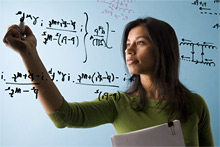Theory

Theoretical physics at Fermilab
Fermilab is a laboratory where advances in particle physics, astrophysics and cosmology converge. At Fermilab, theoretical physicists work hand-in-hand with experimenters. Theorists play a crucial role in making connections among the numerous discoveries made by experiments around the world each year.
Accelerator-based experiments, for example, shed light on the fundamental particles and forces that have governed the evolution of the universe since the big bang. Supersensitive particle detectors, located deep underground, look for the elusive particles that make up dark matter. Powerful telescopes reveal images of galaxies that are many billions of years old and unveil the distribution of dark matter and dark energy. Neutrino experiments examine the role the elusive neutrino played in the formation of the universe, perhaps answering the question why the universe is made of matter instead of antimatter.
Theorists bring together the knowledge gathered from these experiments to find a better, more complete description of the laws of physics. They aim to find the fundamental symmetries and mathematical equations that describe how our universe works. Their ideas, calculations and predictions also guide the future direction of experimental programs. Experimental results, in turn, can confirm or rule out theoretical models, or they can lead to unexpected discoveries that stimulate the development of new theoretical ideas. Theorists and experimenters share the need for new measurements to advance our understanding of the universe.
While theoretical particle physics may seem esoteric, our improved understanding of the subatomic world ultimately has led to better technologies. Modern tools, such as lasers and GPS satellites, rely on the advances made in experimental and theoretical physics. Without a firm understanding of theories such as quantum electrodynamics and general relativity as well as the related mathematical and computational tools, modern applications often would not exist.

Energy frontier
At the most fundamental level, all forces and particles may be related. So far, no one has realized Einstein's dream of a single grand unified force. Supersymmetry and superstring Theory are two approaches that may point in the right direction. Observations of the fundamental interactions of quarks and gluons collected in data from high-energy particle collisions at Fermilab's Tevatron and the Large Hadron Collider at CERN will show the way.
The calculation of phenomena that arise from these high-energy collisions is a difficult undertaking. It commands the use of a wide range of advanced mathematical methods and the development of sophisticated and detailed computer simulations. Members of the Fermilab Theory Department provide input. Based on the knowledge gained by the experiments, they also make predictions of new physics phenomena such as supersymmetric particles and extra dimensions of space.
Scientists know that the Standard Model of quarks and leptons and their interactions is incomplete. Fermilab theorists help create, shape and define theories of new physics that may lie beyond the present Standard Model. They study means to test different aspects of these ideas that are best suited for observation at the LHC and future colliders.
Intensity frontier
Neutrinos may be the reason that we exist. Of all the known particles, they are the most mysterious and the hardest to observe. Their tiny mass may signal new physics at very high energies, beyond the reach of the highest-energy particle colliders.
Members of the Fermilab Theory Department are trying to understand the neutrino mass ordering and how neutrinos are related to astrophysical phenomena. An important area of research is leptogenesis: neutrinos may explain why the universe is filled with matter while antimatter disappeared. Experiments relying on high-intensity proton beams that create large numbers of neutrinos will help solve they mystery.
Particle theories also predict rare subatomic processes that have not yet been observed experimentally, such as the decay of a muon into an electron. Theorists provide detailed calculations of these rare processes, enabling experimenters to test these theories with steadily improving precision.
Cosmic frontier
What is dark energy, the mysterious force that speeds up the expansion of the universe? What is dark matter? How can we make it in the laboratory? These are some of the questions pursued by the Fermilab Theoretical Astrophysics Group.
The group performs research at the confluence of astrophysics, cosmology, and particle physics. It is partially funded by a NASA Astrophysics Theory grant. Its main enterprise is theoretical cosmology, and the group works on topics ranging from early universe string theory to numerical simulations of structure formation.
The Theoretical Astrophysics Group has been instrumental in pushing forward with a new optical survey in the southern hemisphere, the Dark Energy Survey. The survey will measure the abundance and properties of galaxy clusters. The data will yield more information about the nature and distribution of dark energy.
http://www-astro-theory.fnal.gov/


